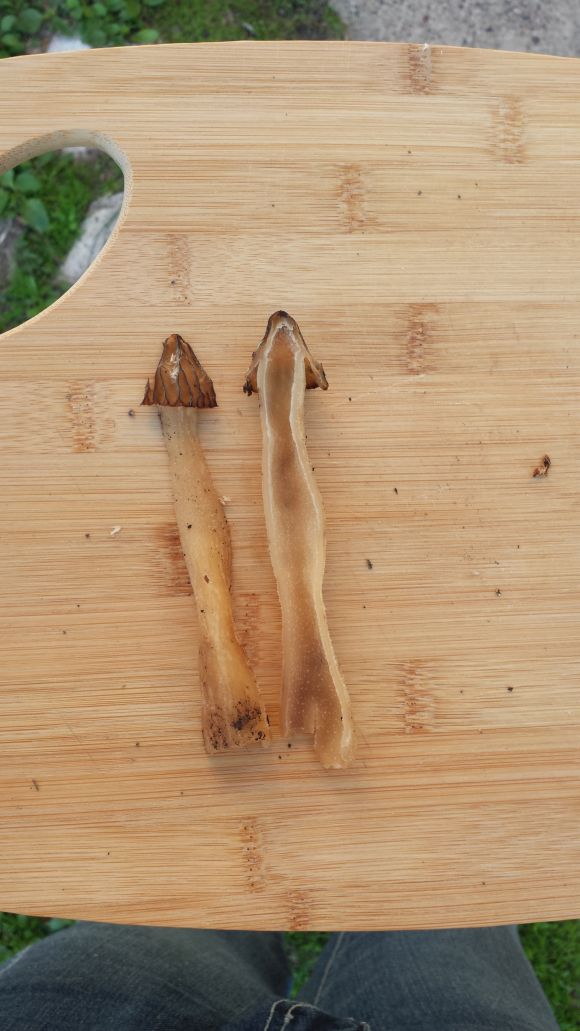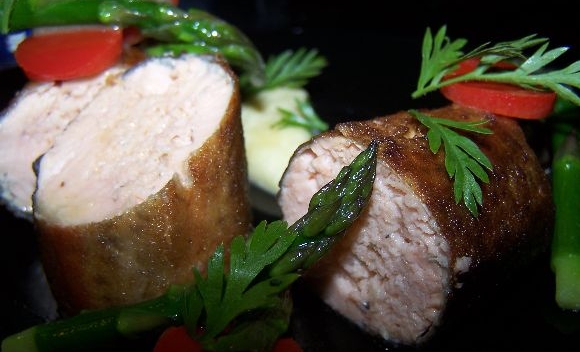
The Half-Free Morel : Morchella Punctipes
Classification & Identification: Still Waiting For Spring in Wisonsin
While we cannot get into our snow covered woods just yet… We’ll look at the Half-Free Morel, which is often one of the first mushrooms of the Morchellaceae family in the Order Pezizales to pop through the foliage in spring. This classification of fungus represents all kinds of morels, some “Cup-shaped” fungi, the Verpa and several other shrooms.
-Pezizales is defined and characterized by having an Asci – [A sac or crevice in ascomycetes (any fungus that carries it’s sexual spores in a sac as opposed to an appendage on it’s body or reproducing asexually) in which the sexual spores are formed]. In this family, the Asci lines the inner surface of a cup or crevice; in regards to the Half-Free Morel (and all other morels) the spores are formed in the “HoneyComb” textured pits of the cap.
I know what you’re thinking…
“I’m interested in finding Mushrooms… Not getting a half-ass, prepubescent science lesson.”
Well it matters, I assure you. Education is King. If you can learn how to correctly identify a fungus by its scientific name; you are becoming acquainted with that mushroom in a way that teaches you the most intimate, subtle, precise details that make that mushroom singularly unique unto itself. When hunting mushrooms; you can never be overeducated. Also, understanding the spores is understanding how to responsibly harvest and promote future regeneration.

This Half-Free Morel is commonly misidentified and as a result is mistakenly a Verpa ( follow the link and take note of the subtle differences in the Photo From Michael Kuo) which could be a costly mistake. I have yet to find a Verpa so I will defer you to a Link form Wildfoodism.com addressing a wide variety of lookalikes. Very important to learn what to look for, and even more so important, learn what to not look for; and the differences. Again with my PSA: Education is King.
The cap of the Half-Free Morel is small, prospectively, and accounts for only a fraction of the total body of this mushroom. The iconic patterning is apparent in the textured cap showing a relationship to the other varieties of Morels. The cap is a conical honeycombed flute, hollow and wide spread at the base. The stem is a long & narrow column running straight into the cap and connecting on the underside roughly midway up. The Cap is perched atop the Stem and when halved lengthwise, you can see that the cap hangs off of the stem resembling the eaves on a poorly illustrated house. This is a tall fungi, standing up to 4-6 inches and again, completely hollow. Many of the Look-a-likes have a similar appearance, but the cap runs into the stem or is connected only at the top of the stem and is “Whole-Free”. The stalk is off-white and the cap is caramel colored to deep brown, making the hard to find & differentiate from it’s surrounding.

And Just for kicks, we’ll throw in some history.
Initially, Half-Free Morels were classified as an all inclusive species called, Morchella Semilibera. In 1903 a gentleman by the name of Charles Horton Peck challenged the European Definition of a Half Free Morel (Morchella Semilibera) and stated in his reseach that the specimen he had tested did not fit the classification because of tiny spikes along the stem. He would go on to coin the term Morchella Punctipes ( Punct -ipes – latin, spotted – stem). In 2011, Michael Kuo (an Amateur North American Mycologist) in association with a Kerry O’Donnel (A North American Micologist with a Ph.D) and company would validate through DNA testing that in fact, the Morchella Semilibera is an indigenous European species and that the Morchella Punctipes and the Morchella Populiphila are American varieties only differentiated by location. The Punctipes is found east of the Rockies and the Populiphila is found in westward states. This is interesting in the mindset of never accepting status quo, and always look to finding an understanding that surpasses what is handed to you…
When & Where : North-Western Wisconsin
Just as Spring sets in; still in the early stage of the woods taking on color, when you can still see into the thick collection of trees. It is in these early hours of spring that you can find the Half-Free Morel. “Legend” has it that the Half-Free Morel is said to be an announcement that the Morel season has begun. The Half-Free Morel shows up a week or two prior to The Yellow Morels, promising a lush harvest. I have only ever found Half-Free Morels in wet, saturated, muddy grounds that have a limited amount of direct sunlight (I.e. a clearing in the trees, or along the edge of the woods).
It was 52°F in mid April, in a year that we had little snow along the 45th parallel. The cloudless skies provided lush amounts of sunshine and the wooded grounds still squished under my boots with each step. In a muddy puddle littered with dead trees, I spotted my first Half-Free Morel. In fact, the puddle was lined along the banks (where the water met the trees) reminding me of street lamps in a park. It was a patch of birch, beech and oak trees; none of which were trees that I had prior associated with any Morels through any of the reading I had done, not because they are not mentioned elsewhere but because they were not an Elm. I doubt we will see anything, let alone mushrooms come mid-April this year, due to it being the 8th and having a foot of snow, and more to come in the forecast. This plays perfectly into the notion that you can kiss time goodbye. You cannot find the exact hour a morel will pop, instead, learn the signs. Focus on the details and catalog your findings. Date (As a frame of reference) Temperature (both outside and of the soil), Map of location, and every detail of the Environment you can jot down in five minutes. Is it a well traveled area? Is there a lot of direct sun or not much? Is it in a clearing or under a canopy of brush? Every detail helps you build a profile and experience and ultimately helps you in finding more. Write a story about finding your mushroom to grow your understanding of the time and place and the growing conditions. A date will not give you the same results of reading how you described the smell to the woods.

Before harvesting a handful, I cut lengthwise splitting my first Half-Free Morel and my confirmation was within the crosscut.
Hollow. Edible, choice fungus. Remember, never eat raw wild mushrooms. They should be cooked prior to consumption; and cooking them in the same manner as you would any morel is suffice. They are not especially a prize when compared to the Yellow or even Black Morels but I have found that I prefer to dehydrate the Half-Free Morels which significantly concentrates the flavor. I like to use these mushrooms in powder form through baking either breads, pastas, soils, cookies etc. The flavor comes through more apparent and showcases the fungi as the Morel it is through this application. The Half-Free Morel is not as pungent as it’s Brothers. It tastes like a lesser / mild morel when seared and eaten. Being that it has such a small cap, it presents perfect practice in training your eyes to spot that honeycomb pattern in the leaves. Remember, you cannot find a mushroom if your not in the woods. Also do just specifically go looking for one thing… Explore everything you see. Education, can’t say enough about it.





One Comment
Roger Medeiros
I found some mushrooms that resemble this morchella. I left them behind being unsure if edible. Look very much like morel’s. I live in southern Ontario. Can’t send picture yet